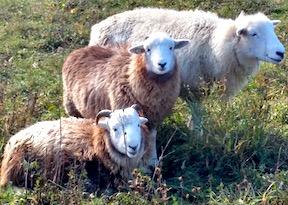
Herdwick sheep, known as the smiling sheep, are born with black bodies and white faces. The first semen was imported to North America in 2008. Increased availability of frozen semen is expanding the genetic base, and several breeders are establishing a national breed registry.
Erin and Ray Bradt have been breeding Herdwicks since 2012. They’ve sold varying percentage Herdwicks from Vermont to Texas. With more than 70 head, Erin is believed to have the largest Herdwick flock in the U.S.
“We first saw them on a PBS special and began to research them,” says Erin Bradt. “I learned about Linda Stimson, who imported the first semen and began a breeding program. We purchased two 75 percent rams and four 62.5 percent ewes from her.”
Bradt added to her genetics in 2018 with semen initially imported by Stimson and again in 2022 with additional semen imports. Since then, she has imported another 400 straws of Herdwick semen. She retained 100 straws, some of which are again for sale.
Introducing a breed through semen imports is a years-long process, especially when import restrictions are put in place or changed. Bradt is excited about the impact of the new genetics and developing the breed. Herdwicks are native to the Lake District in England and survive winter at 3,000 ft. elevation.
“We were looking for an old-fashioned sheep breed that’s low input, and the Herdwicks are awesome,” says Bradt. “They get fat on shrubs and weeds. We practice rotational grazing and have had them on pasture from April through January. We rarely feed grain, except for flushing ewes to breed and for older animals.”
Herdwicks are a dual-purpose wool and meat breed. The fleece is unique, with four separate fibers.
“Farmers who raise them in England attest that they’re the first to dry off after a heavy rain,” says Bradt. “Water sheds right off the fleece. It’s coarse but very warm.”
The breed is slow to mature. Bradt waits up to 18 mos. to breed ewe lambs but has bred ewes as old as 11 years. They tend to produce singles, although she gets some twins. The ewes are excellent mothers, requiring little to no help at lambing.
“I retain only those lambs for breeding with the best Herdwick traits,” says Bradt. “They need to have a good dense fleece and a short stocky body. They must have a clean white face and legs and good hooves.”
While born black-bodied, the fleece on purebred animals lightens with shearing to brown and finally a blue-gray. Bradt suggests that even a 50 percent Herdwick can be born with that breed’s coloring, no matter the foundation ewe.
Her Herdwicks are still larger than purebreds, but she’s getting closer to the 100-lb. average for ewes and 175-lb. average for rams.
Those not retained for breeding are processed at 18 months or older. They have a high meat-to-bone ratio. Although smaller than conventional sheep breeds, Bradt has found roasts to be comparable in size.
“I’ve tasted lamb from many breeds, and the Herdwicks are the best I’ve ever tasted,” says Bradt.
Bradt’s ewes vary in price depending on bloodlines. Ewes bred with AI require laparoscopic surgery from a veterinarian to qualify for the breed registry. Registry in the Herdwick Sheep Breeders Association of North America will also require documented pedigrees.
“Recordkeeping is very important to me,” she says. “As far as I know, my flock is the only fully documented Herdwicks in the country. We’re finalizing bylaws and hope the registry will be up and running by April.”
Bradt hopes to begin importing 100 percent Herdwick embryos in 2025. “The British breed association has accredited the rams,” she says. “I hope to go to England next year to locate the ewes and have embryos collected.”
Herdwicks are ideal for small landholders looking for quality, not quantity, suggests Bradt. “We’re trying to keep the breed affordable,” she says. “It’s such a great breed. We don’t want it to be a fad but a standard for small landholders.”
Contact: FARM SHOW Followup, Helder-Herdwyck Farm, 450 Long Rd., East Berne, N.Y. 12059 (ph 518-872-9081 or 518-505-9081; helderherdwyck@gmail.com; www.helderherdwyckfarm.com) or Herdwick Sheep Breeders’ Association of North America, Inc. (ph 518-872-9081; Herdwicksbana@gmail.com).
